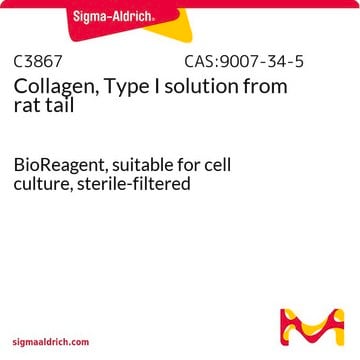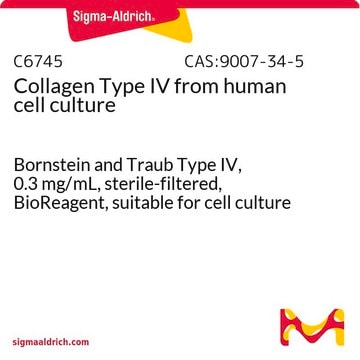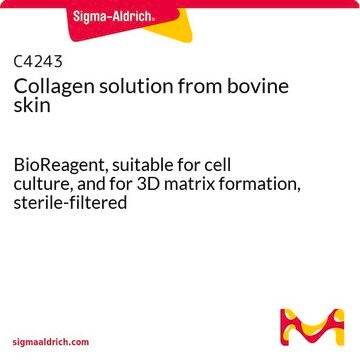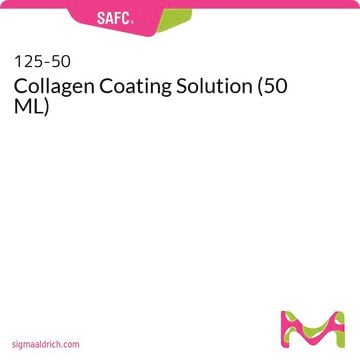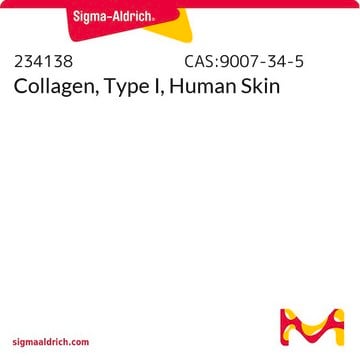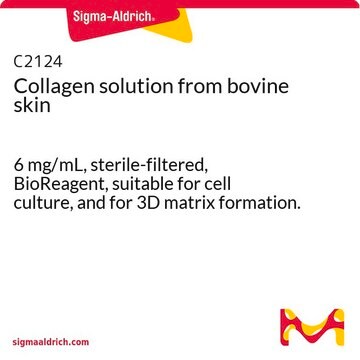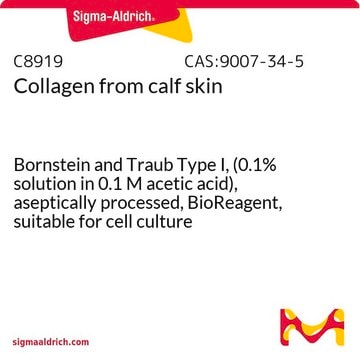There has been no internal protocol for C2249 however this paper describes protocol for 2D Collagen Gel. Hong H, Stegemann JP. 2D and 3D collagen and fibrin biopolymers promote specific ECM and integrin gene expression by vascular smooth muscle cells. J Biomater Sci Polym Ed. 2008;19(10):1279-93. doi: 10.1163/156856208786052380. PMID: 18854122; PMCID: PMC2731795.
C2249
Human Collagen Type I
from human fibroblasts, liquid, 3 mg/mL, suitable for cell culture
Sinónimos:
Collagen Solution, Fibroblast Collagen
About This Item
Productos recomendados
Nombre del producto
Collagen Solution from human fibroblasts, 3 mg/mL, sterile-filtered, BioReagent, suitable for cell culture
origen biológico
human fibroblasts
Nivel de calidad
esterilidad
sterile-filtered
Línea del producto
BioReagent
Formulario
solution
envase
pkg of 20 mL
concentración
3 mg/mL
técnicas
cell culture | mammalian: suitable
cobertura de la superficie
6‑10 μg/cm2
Especificidad de unión
Peptide Source: Collagen
Peptide Source: Elastin
actividad extraña
endotoxin ≤5.0 μmole/min-mg protein
Condiciones de envío
wet ice
temp. de almacenamiento
2-8°C
Descripción general
Aplicación
Acciones bioquímicas o fisiológicas
Código de clase de almacenamiento
10 - Combustible liquids
Clase de riesgo para el agua (WGK)
nwg
Punto de inflamabilidad (°F)
Not applicable
Punto de inflamabilidad (°C)
Not applicable
Elija entre una de las versiones más recientes:
¿Ya tiene este producto?
Encuentre la documentación para los productos que ha comprado recientemente en la Biblioteca de documentos.
Los clientes también vieron
Artículos
Extracellular matrix proteins such as laminin, collagen, and fibronectin can be used as cell attachment substrates in cell culture.
Extracellular matrix proteins such as laminin, collagen, and fibronectin can be used as cell attachment substrates in cell culture.
Extracellular matrix proteins such as laminin, collagen, and fibronectin can be used as cell attachment substrates in cell culture.
Extracellular matrix proteins such as laminin, collagen, and fibronectin can be used as cell attachment substrates in cell culture.
-
What is the 2D Hydrogel protocol for Product No. C2249?
1 answer-
Helpful?
-
-
What solvent is used for product C2249?
1 answer-
The solvent for product C2249 is 13 mM HCl.
Helpful?
-
-
Is the monomer a tropocollagen?
1 answer-
The human collagen is secreted from fibroblast cells, which cleave the loose ends of the procollagen molecule, leaving what is considered tropocollagen with the telopeptide region intact. An enzyme step is utilized to cleave the telopeptide, resulting in Atelocollagen, which maintains its triple helical formation but without the telopeptide region.
Helpful?
-
-
Is this a monomer?
1 answer-
This product is a mix of monomers, dimers, trimers, and oligomers, with some remaining collagen fragments.
Helpful?
-
-
What is the acid, and concentration of acid, that the collagen is solubilized within?
1 answer-
The acid used to prepare this product is HCl. The final concentration of the solvent is 13 mM.
Helpful?
-
Active Filters
Nuestro equipo de científicos tiene experiencia en todas las áreas de investigación: Ciencias de la vida, Ciencia de los materiales, Síntesis química, Cromatografía, Analítica y muchas otras.
Póngase en contacto con el Servicio técnico